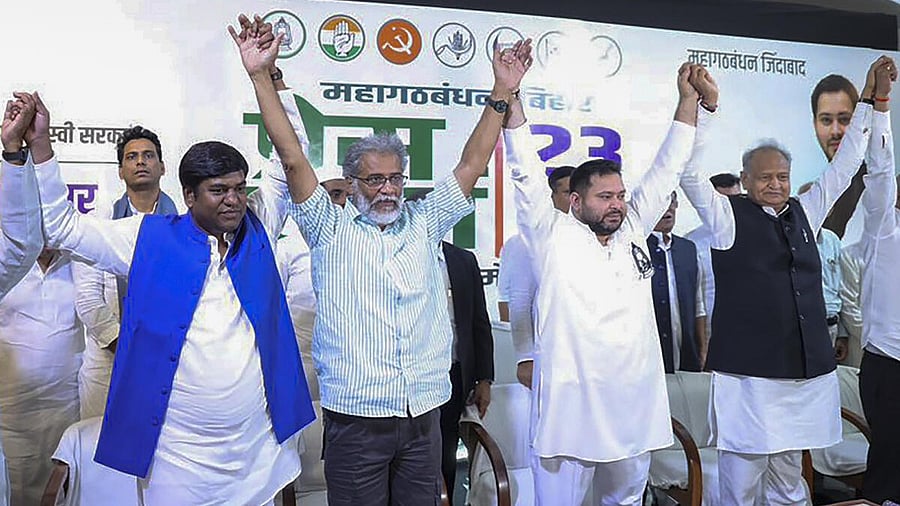
RJD leader Tejashwi Yadav with CPI(ML) Liberation General Secretary Dipankar Bhattacharya, Congress leader Ashok Gehlot and Vikassheel Insaan Party (VIP) chief Mukesh Sahani during joint press conference of the Mahagathbandhan, in Patna.
Credit: PTI Photo
New Delhi: By agreeing to project Vikassheel Insaan Party (VIP) chief Mukesh Sahani as the deputy CM candidate of the I.N.D.I.A. bloc, Lalu Yadav’s RJD has sought to expand the catchment area of its traditional Muslim-Yadav (MY) vote bank to stitch a larger MY-BAAP umbrella coalition by reaching out to other marginalised groups like Bahujan (Dalits), Adivasi (Tribals), and Pichda (Backward, especially Extremely Backward classes).
The arithmetic behind the RJD’s projection of Sahani as Tejashwi Yadav’s deputy can be traced to the Bihar Caste Survey conducted in 2022, when the RJD and the JD(U) were in alliance. The data showed that the Socially and Educationally Backward Classes (also called Other Backward Classes, or OBCs) constitute the largest segment of the state population, at 63%.
The devil, however, lies in the details of sub-categorising the OBC chunk. The survey pooled this social bloc into two separate blocs — Backward Classes or BCs, comprising 30 castes like Yadavs, Kurmis, Bania and Koeris/Kushwaha, who are believed to have benefited relatively more from the Mandal empowerment than the group of 112 Extremely Backward Castes that make up almost 36% of Bihar's population.
Both BC and EBC figures culled out by the caste survey include Muslim communities in the OBC list. Now, of the state's 17.7% Muslim population, almost 4.5% is upper caste. The remaining 13% is distributed among BC and EBC lists.
This 17.7% Muslims, added to 14.26% Yadavs, is the RJD’s core support base. Supported by the CPI(ML) Liberation, which has worked among landless communities in southern Bihar, this number crosses 35 percentage points.
The non-Yadav castes in the BC group (Kurmi, Bania and Koeri/Kushwaha) that make up 13% have been with the JD(U). Even if added to the BJP’s 10.5% Hindu upper caste vote, the number is still 10 percentage points less than the RJD’s MY combine.
To draw parity with the RJD, the NDA brings on board 5.3% Dushadh represented by Chirag Paswan’s LJP (Ramvilas), the largest chunk of the Schedule Caste votes, and a slice of the poorest among the Dalits (Mahadalits) represented by Jitan Ram Manjhi’s HAM.
If one assumes that a majority of the 13% Muslim backward classes are aligned with the RJD, nearly 25% of the Hindu Extremely Backward Caste (EBC) votes remain up for grabs.
After coming to power in 2005, Nitish Kumar, through legislation and welfare schemes, won over a large section of the EBC to preside over a strong anti-Yadav backward bloc.
By anointing Mukesh Sahani from the Nishad community — an EBC caste — as its deputy CM face, the RJD and the I.N.D.I.A. bloc alliance have tried to disrupt the NDA’s winning combination of two decades. The larger message is, Yadavs, the dominant backward caste in Bihar, are willing to offer leadership positions to the Extremely Backward Castes.
The outcome of the Bihar Assembly polls will reveal to what extent the RJD succeeded in convincing the EBC castes of its intent of sharing political power with numerically smaller but cumulatively significant Mandal castes.